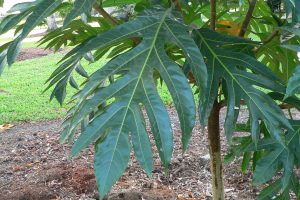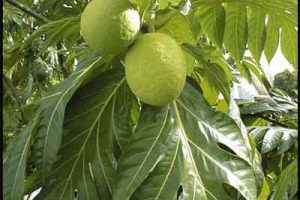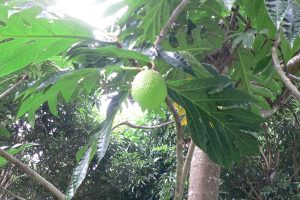Artocarpus altilis
Breadfuit
Origin
Northwest New Guinea and now grown throughout Pacific Oceania. It is believed to have been a hybrid of A. camansi and A. marianennsis, with subsequent changes resulting from human selection.
Climate
The breadfruit is ultra-tropical. An equatorial lowland species, it grows best below elevations of 650m but is occasionally found up to 1,550 m. Optimal rainfall and humidity is 1000-3500mm pa reasonably well-distributed, and 70-90% respectively. Latitudinal limits are 17-23 degrees from the Equator. The average temperature suitable for breadfruit is probably over 21°C. It can withstand brief waterlogging and temperatures up to 40°C but growth stops below 5-10°C and frosts are not tolerated.
Plant Description
The breadfruit tree is a handsome and fast-growing perennial, up to 30 m tall, often with a clear trunk of 0.6-1.8m diameter, 6m height and frequently buttressed at the base. The large, spiral, ovate, coriaceous glossy leaves are 20-60cm long and clustered towards branch terminals, with up to a dozen lobes. All parts of the tree contain a sticky latex.
Relatives
Moraceae Family. Related to breadnut, jakfruit, mulberries and figs.
Soils
Preferred soils are fertile and well-drained with good levels of organic matter and pH of 6-7.5. However it can still grow in sand, sandy loam, sandy clay loam and even in coral and saline soils.
Propagation
The recalcitrant seeds can be used if planted within 2 weeks of removal from the fruit; germination is almost complete. But the better approach is to use root suckers or cuttings. Only limited success has been reported with marcots, budding and grafting.
Cultivars
Chance selections have been made for centuries in Polynesia, resulting in many (50 odd) seedless and seeded varieties that are now cultivated. Each of these shows preference for particular environments. Seedless varieties are typically triploid. In Australia, named varieties include Mason, Noli, Cricket Ball, Rodgers, Samoan Gold and Limberlost.
Flowering and Pollination
The species is monoeceous with solitary staminate and pistillate inflorescences in separate leaf axils. Individual staminate flowers occur on an unbranched axis forming a cylindrical shape, and pistillate flowers arise from a single point producing a more globose shape. The former flowers each have a single stamen while the latter are reduced to a tubular calyx, 2-celled ovary and 2-lobed stigma with a short style. Protandrous dichogamy behaviour favours cross-pollination which can produce a high fruit set (75%). It seems that seedless varieties need pollination but not necessarily fertilization to trigger fruit set, Pollination is normally by wind and insects.
Cultivation
Plant in full sun with some shading for the first year. Fertilization will be necessary for good yields, with the amount increasing according to tree size. A fully bearing mature tree might require 2kg of complete fertilizer pa.
Wind Tolerance
Leaves suffer wind damage but the tree itself, minus maybe some branches, can survive cyclones. Regeneration for a large tree, including the ability to bear fruit, may be complete within a couple of years.
Pruning
Some growers suggest that pruning branches that have borne fruit helps in stimulating new productive shoots. Prune also to maintain a smaller tree size.
The Fruit
The fruit is an indehiscent syncarp, globose to cylindrical, 9-26cm long, 6-20cm wide and weighing 0.2-4.5kg. It develops from the entire inflorescence as the individual flower perianths fuse and become fleshy. The skin is green when immature and reticulated/spiny with seeded varieties, smoother with seedless. The core is surrounded by a white-creamy edible flesh. Seeded types can have 10-150 2.5cm long edible brown seeds. Ripe flesh (excluding the core, seeds and skin) is about 70% of the whole fruit and has 22-37% carbohydrate, most of which is starch; it also has reasonable levels of Ca, Mg and vitamins A and C. It has a mild flavour varying with the degree of ripeness at picking and at eating, and with the variety.
Fruit Production and Harvesting
Seedling-grown trees will begin to bear in 8-10 years and root suckers in 3-5. Canopy volume is a good indicator of yield. Fruit take 13-19 weeks to mature and then a further 5 weeks to ripen, which means harvest can be staggered depending on intended use. Mature green fruit are picked as a starch vegetable, but many people prefer to eat them as a ripe fruit. Maturity is indicated by a slight change in skin colour to a yellowish-green, fruit softening, small drops of latex on the rind and the skin segments becoming more rounded. A ten-year-old tree can produce 50-150 and up to 700 fruits each year,
Fruit Uses
Breadfruit may be eaten ripe as a fruit or under-ripe as a vegetable. Fully ripe fruit is quite sweet. It can also be roasted, boiled, fried, dried, frozen, made into flour and fermented, but many of these processes will degrade vitamins and other nutrients. It is frequently combined with coconut and coconut cream. The seeds, if present are also edible, and represent a good source of protein and minerals.
Pests and Diseases
Possible diseases include dieback, leaf rust, fruit rot (Phytophthora spp) and stem end rot. Fruit rot seems to be more problematic on rough than smooth skinned varieties. Pests might include scales and mealy bugs.
Comments
Growing breadfruit in the south west of WA is a real challenge as it is an ultra-tropical. An additional consideration for backyarders is its possible size and the merit of having multiple trees for good yields. If these considerations can be overcome and given their high productivity in the tropics, you might have a chance of obtaining some fruit here with sufficient tlc. The tree is famous as the reason for Captain Bligh’s notoriously mutinous voyage.


